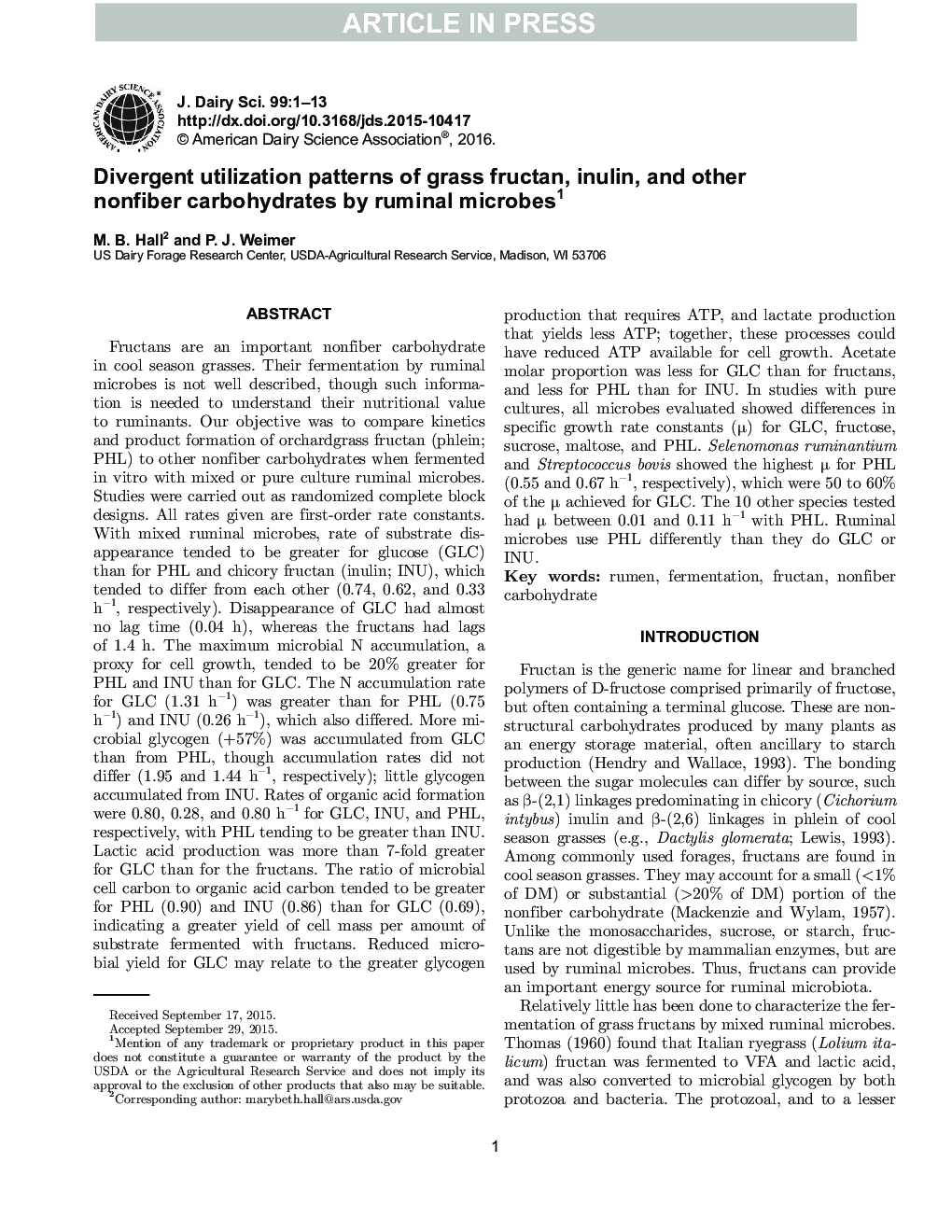| کد مقاله | کد نشریه | سال انتشار | مقاله انگلیسی | نسخه تمام متن |
|---|---|---|---|---|
| 10974003 | 1108021 | 2016 | 13 صفحه PDF | دانلود رایگان |
عنوان انگلیسی مقاله ISI
Divergent utilization patterns of grass fructan, inulin, and other nonfiber carbohydrates by ruminal microbes1
ترجمه فارسی عنوان
الگوهای استفاده مجدد از فروکتان چمن، یونولین و دیگر کربوهیدراتهای غیر کربن با میکروب های شنیده 1
دانلود مقاله + سفارش ترجمه
دانلود مقاله ISI انگلیسی
رایگان برای ایرانیان
کلمات کلیدی
شکمبه تخمیر فروکتان، کربوهیدرات غیر کربناته،
موضوعات مرتبط
علوم زیستی و بیوفناوری
علوم کشاورزی و بیولوژیک
علوم دامی و جانورشناسی
چکیده انگلیسی
Fructans are an important nonfiber carbohydrate in cool season grasses. Their fermentation by ruminal microbes is not well described, though such information is needed to understand their nutritional value to ruminants. Our objective was to compare kinetics and product formation of orchardgrass fructan (phlein; PHL) to other nonfiber carbohydrates when fermented in vitro with mixed or pure culture ruminal microbes. Studies were carried out as randomized complete block designs. All rates given are first-order rate constants. With mixed ruminal microbes, rate of substrate disappearance tended to be greater for glucose (GLC) than for PHL and chicory fructan (inulin; INU), which tended to differ from each other (0.74, 0.62, and 0.33 hâ1, respectively). Disappearance of GLC had almost no lag time (0.04 h), whereas the fructans had lags of 1.4 h. The maximum microbial N accumulation, a proxy for cell growth, tended to be 20% greater for PHL and INU than for GLC. The N accumulation rate for GLC (1.31 hâ1) was greater than for PHL (0.75 hâ1) and INU (0.26 hâ1), which also differed. More microbial glycogen (+57%) was accumulated from GLC than from PHL, though accumulation rates did not differ (1.95 and 1.44 hâ1, respectively); little glycogen accumulated from INU. Rates of organic acid formation were 0.80, 0.28, and 0.80 hâ1 for GLC, INU, and PHL, respectively, with PHL tending to be greater than INU. Lactic acid production was more than 7-fold greater for GLC than for the fructans. The ratio of microbial cell carbon to organic acid carbon tended to be greater for PHL (0.90) and INU (0.86) than for GLC (0.69), indicating a greater yield of cell mass per amount of substrate fermented with fructans. Reduced microbial yield for GLC may relate to the greater glycogen production that requires ATP, and lactate production that yields less ATP; together, these processes could have reduced ATP available for cell growth. Acetate molar proportion was less for GLC than for fructans, and less for PHL than for INU. In studies with pure cultures, all microbes evaluated showed differences in specific growth rate constants (μ) for GLC, fructose, sucrose, maltose, and PHL. Selenomonas ruminantium and Streptococcus bovis showed the highest μ for PHL (0.55 and 0.67 hâ1, respectively), which were 50 to 60% of the μ achieved for GLC. The 10 other species tested had μ between 0.01 and 0.11 hâ1 with PHL. Ruminal microbes use PHL differently than they do GLC or INU.
ناشر
Database: Elsevier - ScienceDirect (ساینس دایرکت)
Journal: Journal of Dairy Science - Volume 99, Issue 1, January 2016, Pages 245-257
Journal: Journal of Dairy Science - Volume 99, Issue 1, January 2016, Pages 245-257
نویسندگان
M.B. Hall, P.J. Weimer,
